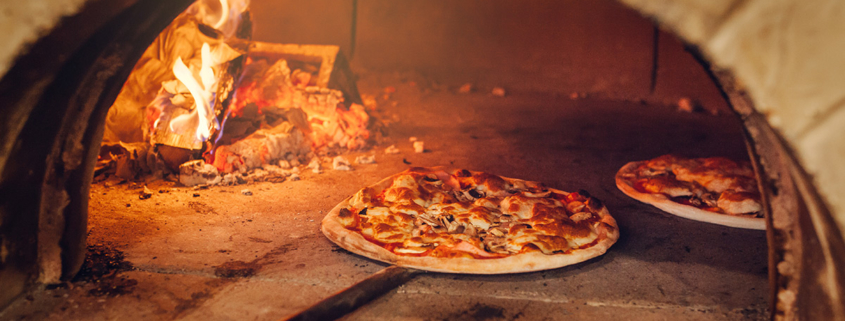What Is the Best Wood to Use in a Pizza Oven?
It’s fair to say that Brits love pizza. The average person in the UK will eat an astounding 731 pizzas in their lifetime. In the US, 350 slices of pizza are eaten every second with 13% of Americans eating pizza every single day. However, did you know that despite being a staple menus item in every Italian restaurant, pizza isn’t actually Italian?
You have to travel to the seafront city of Naples in 600 BC to find the very first pizza. Founded by the Greeks, it was named Neapolis meaning new city. When established, the Greeks brought their culinary traditions with them – pizza.
A traditional flatbread dressed with olive oil, cheese and herbs cooked in an open-air oven; pizza quickly became popular with residents. Throughout the centuries, pizza remained on the dinner plate, however, in 17th century the Italians started using yeast to get the dough to rise and added toppings like tomato and onion and thus the pizza that we all eat today was born.
This traditional way of cooking Neapolitan pizza has seen a resurgence in recent years. Restaurants with wood burner pizza ovens have sprung up on the high street, and they can even be found in people’s homes! Given that you can cook a whole pizza in a fraction of the time of an oven with a delicious chargrilled flavour, it’s not hard to see why.
So, if you’re considering installing a pizza oven in your home or restaurant, or you’re a foodie and want to learn how to cook a delicious Neapolitan pizza, here’s a guide to the best wood to use in a pizza oven.
Beech (Fagus spp.)
The most popular wood use in a pizza oven in Italy is beech (or Fagus spp.) Europe beech is abundant in Italy and has the common name of Faggio. Like other hardwoods, beech needs a high temperature to ignite, but it catches fire quickly and burns with a lively flame.
Not quite as intensive as oak, beechwood is a great option for a consistent cook, which shouldn’t be too surprising when you consider that beech is the primary raw material for charcoal production.
The only drawbacks are that this greenwood has a high moisture content (as much as 90%) and that it’s sensitive to weather conditions, pests and beetles. If you want to use beech, make sure to ask your supplier how long the wood has been dried out and that it has not been exposed to the elements. Other than that, beech is a great wood to use in a pizza oven!
Oak (Quercus spp.)
There are several different species of oak, all that are great for pizza ovens, but the most popular is a species of white oak called Roverella (Quercus pubescent).
A dense wood with a very high heat value, Roverella oak is highly sought after. Oak is different from beech because the flame is not as lively or intense. However, it has a consistent heat, creating the ideal number of hot embers for a pizza oven.
The Italians use oak to warm up their pizza ovens. Remember though, oak must be seasoned for between 24-36 months. Why? It catches fire easily and creates a lot of smoke and soot otherwise.
Oak can be quite expensive. Whereas oak isn’t used as the primary wood in a wood burner pizza oven, it’s not uncommon for pizzerias to mix oak with beech or ash to make sure the oven has a warm and consistent temperature.
Hornbeam (Carpinus spp.)
Another option is Hornbeam. This wood is renowned for its long-lasting burn and high density. It may be difficult to split, but Hornbeam is still used in wood burner pizza ovens in restaurants and home across the UK every day.
Carpino Nero (a species of Hornbeam) is a very dense and heavy hardwood. It can be quite difficult to split, especially if it’s already dry. But well-seasoned, dry Hornbeam is great for pizza ovens. It burns well, has a consistent middle flame, and produces a lot of embers.
The only real drawbacks are that Hornbeam can be sensitive to weather conditions. If you’re planning on using Hornbeam, you’ll have to make sure that it is well sheltered (if you’re storing the wood outside.) It also has a slow seasoning period of between 24-30 months which doesn’t appeal to everyone.
Olive (Olea spp.)
Arguably, the most valuable firewood for pizza ovens is olive. The olive tree grows very slowly which makes the wood very dense. This high density is complemented by a hardness which makes olive wood more robust than oak.
It’s not uncommon for hard woods to not burn as well as softer woods, however olive is different. Creating a lot of hot embers, olive wood without the crackling. Not only that, olive wood has a delicious aroma when first burnt.
Not quite as common as beech, oak or ash, olive wood can be a little more expensive. It’s better to buy billets than logs to save money. Also, splitting olive is a difficult task because its hard and knotty. If you’re planning on splitting olive, make sure you have the right tools.
Ash (Fraxinus spp.)
Ash may have a reputation as the best species for firewood, but it can also be used in a pizza oven. With a low moisture content (less than 50%), it can be split effortlessly and dried quickly. When burned, ash gives off a consistently high temperature making it ideal for cooking pizzas.
The industrial sector is the largest consumer of ash. The toughness of the wood makes it ideal for chairs, woodwork, even cricket bats, but that doesn’t stop some pizzerias from burning ash to cook their pizzas.
What Wood Should I Choose?
The choice of which wood to use in the wood burner pizza oven is really up to you. The good news is that you have a range of options, with each individual wood having its own unique characteristics.
If you’d like to get further advice, don’t hesitate to get in touch with Firewood for Stoves on 0333 300 1299! We’d be happy to help you find the ideal wood for your wood burner pizza oven.





Leave a Reply
Want to join the discussion?Feel free to contribute!